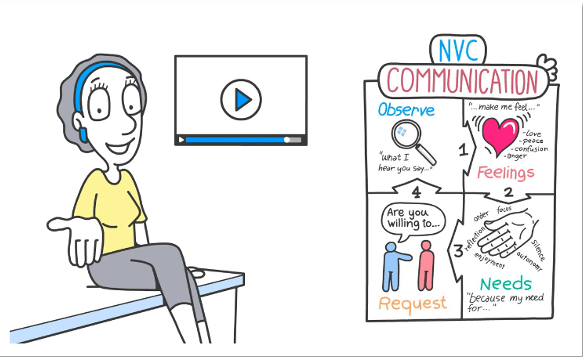As a female teacher, I often have male students trying to challenge me to see how far they can take things before I get angry. Here is an analysis of one of these situations and how I used nonviolent communication to help myself deal with it.
If he intended to make me angry, he succeeded! I’m boiling inside. I want to shout at him what a horrible person he is, but I can’t do that for many reasons; one is I want to keep my job.
From a Nonviolent Communication course, I know nobody can make me angry (Did that provoke you? That idea definitely provoked my the first time I heard it. But, it’s very powerful!). It’s what I’m thinking about the other person that is creating the anger… I’m angry because I’m thinking:
- He wants to make me angry to show that he has power over me.
- He’s terrified of attractive women because he doesn’t know how to handle them.
- I bet he has a small dick, and he is trying to compensate for his lack of masculinity.
So, how can I apply my knowledge of Nonviolent Communication to this situation?
I begin by taking a few deep breaths without saying anything. After that, I acknowledge all the thoughts flying through my head.
My anger is mine! Who does he think he is if he thinks he can anger me?
What needs do I have in relation to this situation?
I have a strong need for respect, not only as a teacher but also as a woman. I also feel that my self-worth is threatened. I’m here because I want to help these people and need a calm classroom.
From my Nonviolent Communication course, I know that when I’m angry, I’m not in touch with my needs. But what happens when I focus on my needs?
THE ANGER IS TRANSFORMING!
Instead of being angry, I feel uncomfortable and sad. Even if I feel lonely and vulnerable in front of the class, I am determined to do something about the situation.
By now, I’ve given myself enough self-empathy to take action. As I see it, I have two choices:
- To tell the person how I feel
- To focus on him
I have to disclose one more thing about myself. People often see me as easy prey. I’m the kind of woman who, on the outside, appears to be soft, or as some men would phrase it, a push-over.
So, standing up for myself is equally important as showing others that I don’t accept their behavior. I need to show that I’m not a pushover!
Let’s see what happens if I take the first route, to tell the person how I feel.
Me:
– Stop for a moment! When you say things like that, I feel sad because I want to feel respected as a teacher and woman. I came here today to teach because it’s important to me to see you succeed in life.
– When you say things like that, I feel lonely and vulnerable standing in front of the class because I want to be accepted for who I am.
– How do you feel when I say that? / Could you tell me what you heard me say?
When I open up with a question like How do you feel when I say that, I need to be prepared to listen with empathy (put the giraffe ears on) to whatever he will say next.
My guess here, and only my guess, is that when I show I’m vulnerable, it’s not fun to make me angry anymore. To tease someone or make them angry can be fun (trust me, I’ve done it many times), but it’s another thing to hurt or make someone sad. I don’t think people want to do that.
Let’s try the second route to put my attention to his feelings and needs.
To do that, I need to listen to what he’s saying. In this case, I only have my own thoughts about him to guess what he’s feeling and needing.
What feelings are behind a thought like: “He’s terrified of attractive women”? I guess that he feels uncomfortable and insecure about himself around women.
How about: “he wants to show that he has power over me”? Some might say power is needed, but I believe it’s more of a strategy to get something else. For instance, we might seek power to make a difference, create meaning, or reach a goal we have. I guess that he wants to be seen or acknowledged.
I believe he’s insecure and wants respect and approval from the group. He doesn’t know how to get it because nobody has ever taught him how to behave around people. Therefore, he is clumsy, and he uses the only method he knows to get attention: trying to get someone else to show weakness.
Naturally, I don’t know what is happening in his head yet… My guesses are as good as yours. However, I’m not angry anymore… I feel sad for the guy, and as the teacher I am, I’d like to help him…
I believe I’d start the conversation with something like this:
Me:
‘Oh, now you sparked my curiosity! Could you please elaborate on that?‘
I’d use curiosity to create an initial contact. Curiosity can hardly be perceived as criticism. I’m moving the focus to him by asking the person to elaborate. It means I get some time and information before I (if I want) ask about his feelings and needs.
Learning about Nonviolent Communication can be frustrating, but once we gain a small understanding of what happens around us, it’s truly amazing! This post is part of our Nonviolent Communication Video Course. Here is a link to the Course page if you want to learn more. Don’t miss the opportunity to learn nonviolent communication truly. It can help you in so many areas of your life.


